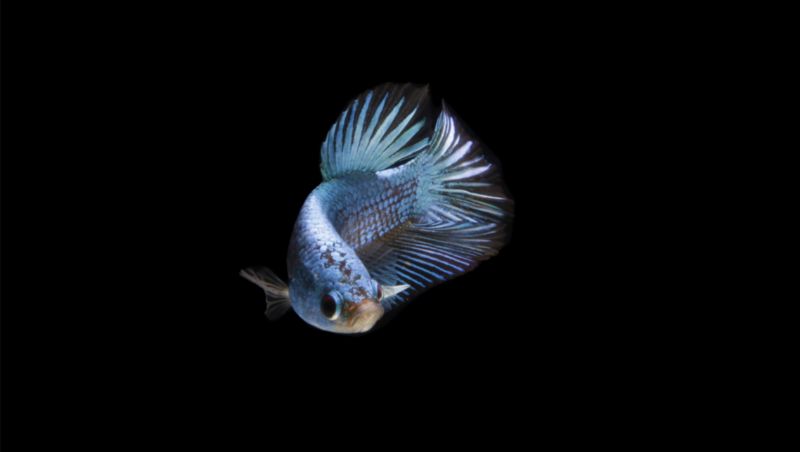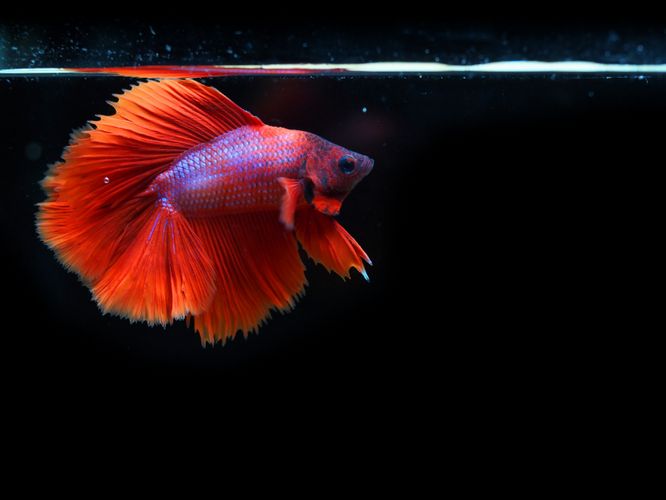Are you thinking about getting a betta fish, but aren’t sure how big it’ll get? The baby bettas in the stores are so tiny that it’s hard to imagine them as adults. You’ve likely heard of people keeping bettas in bowls, so that means they don’t get very large, right?
So, exactly how big do betta fish get?
This depends on the care given to the betta as well as the type of betta. The typical betta fish that we find in pet stores won’t grow very large. Still, there are less common giant bettas that grow bigger.

When they are full-grown, bettas will reach an average of 2.25 in (5.7 cm).
Most betta fish will reach their full size at about 7 months of age. Still, it’s possible for them to grow even larger if they’re in an optimal environment. Some bettas have even grown as large as 3 in (7.6 cm).
The Betta Fish Growth Cycle
If you’re not sure how old your new betta is, you can tell by the size of its body. Below is a breakdown of how much a betta grows as it ages, and should help to answer your question on how big do betta fish get:
- 1 Day Old: 0.1 inches (2.55 mm) long with no obvious tail
- 1 Week Old: 0.2 inches (5.08 mm) long
- 2 Weeks Old: 0.25 inches (6.35 mm) long with the dorsal fins beginning to appear
- 3 Weeks Old: 0.34 inches (8.64 mm) long
- 4 Weeks Old: 0.45 inches (11.43 mm) long
- 5 Weeks Old: 0.5-0.75 inches (12.7-19.05 mm) long
- 6 Weeks Old: 0.85-1 inches (21.59-25.4 mm) long
- 7 Weeks Old: 1.1 inches (2.79 cm) long
- 8 Weeks Old: 1.3 inches (3.3 cm) long
- 9 Weeks Old: 1.55 inches (3.93 cm) long
- 10 Weeks Old: 1.7 inches (4.32 cm) long
- 11 Weeks Old: 1.9 inches (4.83 cm) long
How Old Are The Bettas Sold In Stores?
Most pet stores sell bettas that are around 6-12 months of age, so they’re likely full-grown already.
If you place them into a nice tank, they may continue to grow a bit. Still, you shouldn’t notice much of a size difference from when you bought them.
Yet, some stores are starting to sell bettas younger and younger. Many of these fish are only about an inch long with small fins, so they still have plenty of growing to do.
If you’re new to fish keeping, we recommend going for one of the older bettas. They’re going to be hardier and easier to take care of. But, if you’re up for the challenge, it can be very rewarding to watch a baby betta grow up.
How Big Is A Full-Grown Betta Fish?

Most full-grown bettas will reach an average size of 2.25 in (5.7 cm). Yet, some can grow as large as 3 in (7.6 cm).
How Big Do Male Betta Fish Get?
Generally, males and females will have the same average body length. Still, if you take their fin length into account, males will almost always be larger.
Most male bettas sold in stores have long, flowy fins. The fins are what bettas are known for and are what makes them so popular.
There are a few exceptions where males have short fins like females, such as with placket bettas. But on average, a male’s fins will be about 0.5 in (1.27 cm) longer than a female’s. Males also tend to have thicker bodies than their female counterparts.
How Big Do Female Betta Fish Get?
As we mentioned, a female’s body size will be about the same as a male’s. Their fin size is where the difference comes in. Females have shorter, stubbier fins that make them appear shorter than males.
How Big Can Wild Betta Fish Get?
Wild betta fish and captive betta fish grow to about the same size. It is rare that you will find a wild betta that is much larger than captive-bred bettas.
The main difference between wild and captive bettas is not size, but color. Wild bettas are generally a duller color than the brightly decorated fish we see in stores.
How Big Do Giant Betta Fish Get?
Giant betta fish aren’t as common as their smaller cousins. Still, many fishkeepers love to own them. They are unique and easier to view than common betta fish.
As the name suggests, these fish grow very large. They can grow to over twice the size of a normal betta fish, reaching sizes of up to 5 in (12.7 cm).
Giant bettas have been selectively bred for their large size. Breeders would select their largest common bettas and breed them. This resulted in fry that were larger than regular fry. After doing this over and over, we’ve got giant bettas!
The great thing about giant bettas is that they keep the beautiful colors. That is why we love bettas so much after all!
Giant bettas do need slightly different conditions than common bettas. So, be sure to do your research before picking one of these guys up.
What Influences Your Bettas Size?

Unlike goldfish, bettas don’t continue to grow for their entire lives. They will stop growing at about 7 months of age, regardless of how big they are. So, if a betta is stunted and it’s already an adult, there’s nothing that will correct that.
The best thing you can do for your betta is to provide the optimal environment for them. Give them at least 5 gallons of water to swim in with lots of hiding spots. Also, make sure that the water stays clean and healthy.
One of our favorite betta foods is BugBites by Fluval. You should also aim to give them regular feedings of frozen or fresh brine shrimp. Avoid generic tropical flakes and opt for food made for bettas.
See Price of BugBites Betta Food Here
If you do all these things, your betta should become big and strong.
A stunted betta is usually the result of living in a tank that has poor water conditions. Stunted growth can also occur if you don’t provide your baby betta with enough nutritious food.
Unlike goldfish, a betta’s growth won’t really become stunted due to a tank that is too small. But, tanks that are too small often lack filtration, heaters, and proper water quality. Poor water conditions will stunt your betta’s growth.
Healthy and well cared for betta fish grow to about 2.25 in (5.7 cm) and live for about 2-4 years.
Conclusion
On average, full-grown bettas reach about 2.25 in (5.7 cm) in length. Yet, if you buy them young and provide exceptional care, they may grow slightly larger than that.
Wild bettas don’t grow much larger than their domesticated cousins. But, giant bettas grow significantly larger, reaching up to 5 in (12.7 cm).

